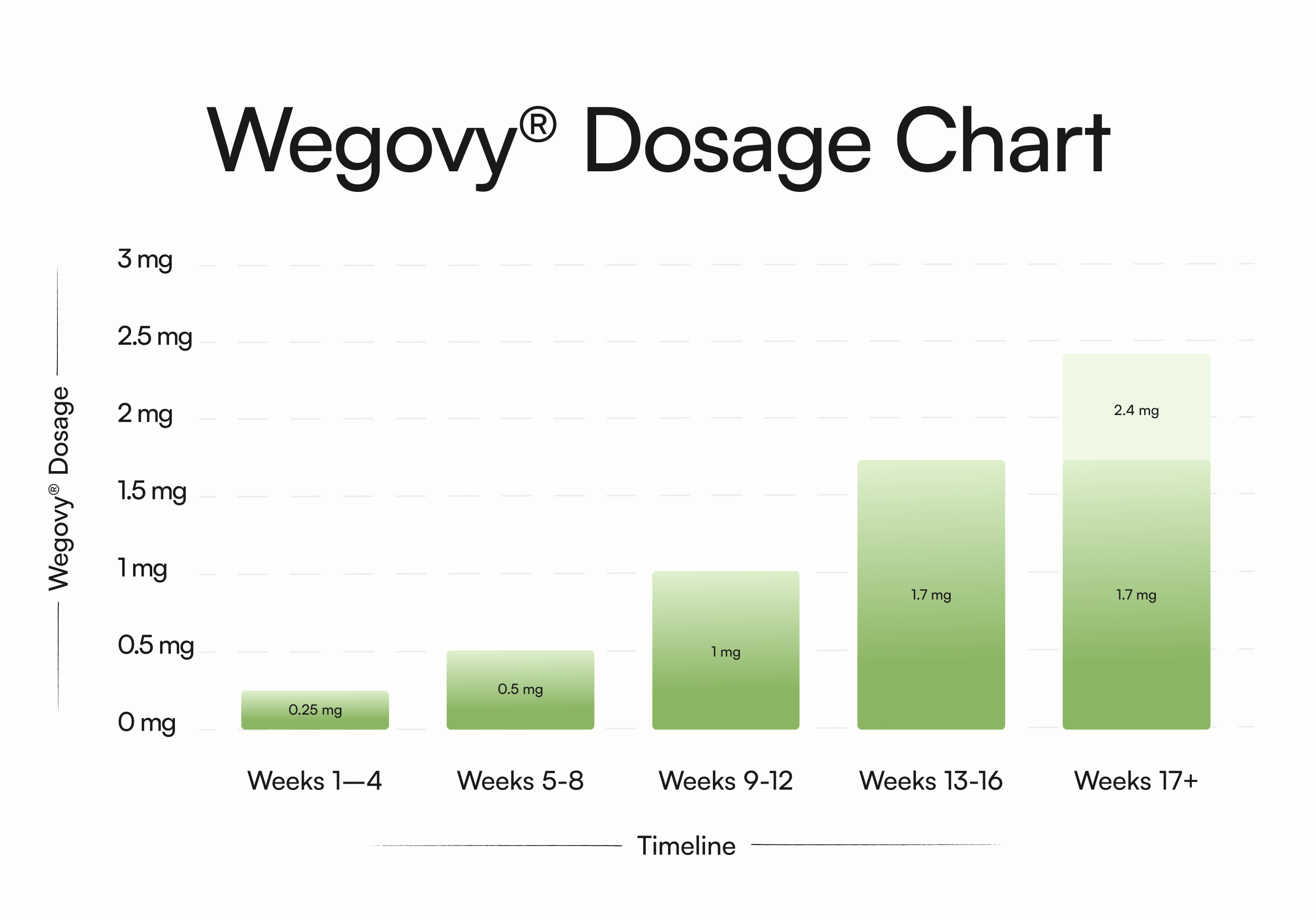Semaglutide Weight Loss Dosage Chart (Printable): Starter-to-Maintenance Dose
See the FDA-labeled Wegovy® dose escalation schedule (0.25→2.4 mg), how and when to titrate, and practical tips to improve tolerability, plus a printable chart.
- Start with 0.25 mg once weekly and increase every 4 weeks to reach maintenance doses of 1.7 mg or 2.4 mg as tolerated and directed by your clinician.
- Personalize your approach by delaying increases if you experience side effects. Some patients remain at 1.7 mg if 2.4 mg isn’t tolerated.
- Clinical trials of Wegovy® 2.4 mg showed ~14.9% average weight loss at 68 weeks vs 2.4% with placebo when paired with lifestyle changes.
- Plan for long-term use (many patients require ongoing therapy; duration is individualized), as weight regain can occur after discontinuation.
- Combine semaglutide with lifestyle modifications (nutrition + activity) for sustained weight management.
- Monitor progress and side effects regularly with your healthcare provider to ensure safety and optimize results.
- This guide summarizes FDA-approved dosing for Wegovy®.
Studies show people using Wegovy® (semaglutide 2.4 mg) for weight loss lose an average of ~14.9% of their body weight over 68 weeks vs ~2–3% with placebo when paired with lifestyle changes. Individual results vary.
Your success with Wegovy® depends on following the right dosage schedule. The medication works best with a gradual approach that helps your body adjust while reducing side effects. Most patients start with 0.25 mg weekly, then slowly increase to 1.0–2.4 mg weekly per the FDA-labeled schedule and clinical judgment.
The highest FDA-approved dose for chronic weight management with Wegovy® is 2.4 mg once weekly. Finding your ideal maintenance dose requires careful monitoring with your healthcare provider. Some patients remain at 1.7 mg if they don’t tolerate 2.4 mg. In weight-management trials per the Wegovy® FDA labeling, ~6.8% of patients discontinued due to adverse reactions; in a longer cardiovascular outcomes study, ~16.6% discontinued due to adverse events. Talk with your clinician about benefits and risks.
This article provides a dosing chart to guide you from starter doses through maintenance. You'll learn how to increase your medication per the FDA-labeled schedule (measured in mg), and develop a clinician-guided plan that balances effectiveness with comfort.
{{primary-cta}}
How Semaglutide Works for Weight Loss
Semaglutide mimics the natural hormone GLP-1, activating receptors that control appetite and glucose metabolism. The medication slows stomach emptying and signals the brain to reduce hunger. In a pivotal trial of adults without diabetes, Wegovy® produced ~12.4 percentage points greater weight loss than placebo at 68 weeks.
GLP-1 receptor agonist explained
Semaglutide is a glucagon-like peptide-1 (GLP-1) receptor agonist that shares high structural similarity with the natural human GLP-1 hormone. Natural GLP-1 breaks down quickly in the body, but semaglutide has been modified to resist this breakdown. The medication contains modifications that increase albumin binding and reduce enzymatic degradation.
These structural changes extend semaglutide’s half-life to approximately one week, allowing for once-weekly dosing. When you receive semaglutide, it selectively binds to and activates GLP-1 receptors throughout your body, particularly in the pancreas, gastrointestinal tract, and brain.
Appetite control and insulin sensitivity
Semaglutide creates weight loss primarily by reducing how much you eat through decreased appetite. The medication activates receptors in your brain, particularly in the hypothalamus and brainstem, that control hunger and fullness. It stimulates neurons that create feelings of satisfaction while blocking neurons that trigger appetite.
Semaglutide also affects your digestive system in several ways:
- Slows gastric emptying, prolonging feelings of fullness
- Decreases preference for high-fat, energy-dense foods
- Improves control over eating and reduces food cravings
Research shows participants taking semaglutide (using the Wegovy® formulation) consumed ~24% fewer calories across all meals throughout the day (~3036 kJ) compared to those taking placebo in a randomized, double-blind, placebo-controlled crossover study after 12 weeks of treatment.
Why semaglutide is effective for people without diabetes
Semaglutide was originally developed for diabetes management, but it has proven highly effective for weight loss in non-diabetic individuals. Clinical trials show adults without diabetes lost ~12-13 percentage points more body weight than placebo over 68 weeks (using the Wegovy® formulation of semaglutide).
For non-diabetics, semaglutide produces notable results (using the 2.4 mg Wegovy® formulation of semaglutide):
- Can reduce total and visceral fat mass
- Increases the proportion achieving ≥5%, ≥10%, and ≥15% weight loss compared to placebo
- A subset achieves ≥20% weight loss, though results vary
There is limited evidence for consistently meaningful weight loss at sub-maintenance doses over short periods; follow your clinician’s plan and the labeled titration.
Understanding the Semaglutide Dosage Chart
Starter dose: 0.25 mg weekly
The Wegovy® dosage chart always begins with a starter dose of 0.25 mg injected once weekly for the first four weeks. This initial dose allows your body to gradually adapt to the medication and reduces the likelihood of gastrointestinal side effects. Clinical evidence (per Wegovy’s FDA label) shows that starting with this lower dose and escalating gradually substantially improves medication tolerance.
Titration phase: increase every 4 weeks
After the starter period at 0.25 mg, the dosing chart follows a structured titration schedule with increases occurring at 4-week intervals:
- Weeks 5–8: 0.5 mg once weekly
- Weeks 9–12: 1.0 mg once weekly
- Weeks 13–16: 1.7 mg once weekly
Your body gradually adjusts to the medication during this phase. If you experience difficulty tolerating a dose increase, your healthcare provider may delay the increase by an additional 4 weeks. Your clinician will tailor escalation based on tolerability.
Maintenance dose: 1.7–2.4 mg weekly
At week 17, your doctor will determine the appropriate maintenance dose based on your response and tolerance. For most individuals, the maintenance dosage will be either 1.7 mg or 2.4 mg once weekly. If the 2.4 mg proves difficult to tolerate, your provider may temporarily decrease it to 1.7 mg for up to 4 weeks before attempting to increase again. The maximum recommended dose for weight management is 2.4 mg weekly.
Open printable Wegovy® Dosage Chart

{{primary-cta}}
Personalize Your Semaglutide Plan
Your response to semaglutide may differ from what others experience. Various factors including age, sex, body composition, kidney function, and concurrent medications all influence how you'll respond to treatment.
Microdosing for sensitive users
Some patients benefit from a slower escalation than the standard schedule to improve tolerability. Any off-label starting doses or schedules should be determined by your clinician.
Adjusting based on side effects
You don't have to push through uncomfortable side effects. If dose escalation proves difficult, your doctor may recommend delaying the next increase by four weeks. Some patients who cannot tolerate the maintenance dose of 2.4 mg find that temporarily reducing to 1.7 mg for up to four weeks helps. There is limited evidence that substantially lower doses provide the same long-term results; follow your clinician’s guidance.
Your healthcare provider will monitor side effects, appetite changes, and weight loss progress throughout this process. Regular check-ins ensure both effectiveness and safety.
When to taper or maintain your dose
Once you reach your weight loss goals, you have options for what comes next. Stopping therapy is often followed by weight regain; any tapering approach should be individualized, and evidence is still emerging.
Some patients find that lower doses (e.g., 1.7 mg) work well for sustaining results with fewer side effects. This approach maximizes benefits while reducing the amount of medication you need when appropriate.
Long-Term Use and Monitoring
Semaglutide weight management typically requires long-term treatment, individualized to your health status and goals. Regular monitoring of vital signs, weight loss progress, and side effects helps ensure both safety and effectiveness. Reducing dosage to 1.7 mg may help manage side effects while maintaining benefits. Your best results come from combining semaglutide with healthy lifestyle habits.
How long to stay on semaglutide
Most clinical trials studying semaglutide duration lasted between 68 weeks and 2 years. Healthcare providers typically recommend an individualized duration for weight management. The STEP 5 clinical trial (using the Wegovy® formulation of semaglutide) confirmed safety and effectiveness for up to 2 years, with participants maintaining 15.2% body weight reduction compared to just 2.6% with placebo.
Patients who stop semaglutide often regain weight. Clinical evidence shows weight regain begins soon after stopping treatment as appetite and caloric intake increase. Many healthcare professionals consider obesity a chronic condition that may require ongoing medication management.
Tracking weight loss and health markers
Consistent monitoring ensures your treatment remains both safe and effective. Important markers to track include:
Your healthcare provider should assess you for potential complications, including gastrointestinal effects, dehydration, gallbladder disease, and pancreatitis.
When to consider dose reduction
Your dosage may require adjustment over time. If the 2.4 mg weekly dose causes intolerance, healthcare providers often reduce it to 1.7 mg weekly for up to 4 weeks before attempting to increase again. Some patients maintain results at 1.7 mg; dosing is individualized.
If you want to discontinue semaglutide, talk to your clinician. Evidence on tapering strategies is limited; weight regain is common after stopping.
Lifestyle habits to support results
Semaglutide works best alongside lifestyle changes. Official recommendations emphasize combining the medication with a balanced diet and regular exercise. Patients who exercised while using weight loss medication kept off substantially more weight after stopping treatment compared to non-exercisers.
Consider these foundational habits:
- Focus on whole foods, including vegetables, lean proteins, and high-fiber options
- Aim for 150 minutes of moderate physical activity weekly
- Establish regular meal patterns and portion control
- Work with dietitians or support groups to reinforce behavioral changes
A structured weight management program can support your journey regardless of whether you continue semaglutide long-term.
Conclusion
Semaglutide can help you achieve significant weight loss when you follow the right dosage plan. The medication's effectiveness depends on sticking to the appropriate schedule designed for your specific needs. Starting with low doses of 0.25 mg weekly, then gradually increasing to effective levels allows your body to adjust while reducing uncomfortable side effects.
Each person responds differently to semaglutide treatment. Some patients achieve excellent results with lower maintenance doses, while others benefit from the maximum 2.4 mg weekly dose. Your healthcare provider might recommend slower escalation or extending time between increases if you experience side effects.
Semaglutide works best when combined with healthy lifestyle changes. Regular check-ins with your doctor help ensure both safety and effectiveness. Adding nutritious eating habits and consistent physical activity will enhance your results significantly.
Weight management typically requires long-term treatment. Most studies show optimal results when semaglutide is continued over extended periods. Working closely with your healthcare provider to develop a sustainable plan designed for your needs determines your success with this medication.
You can achieve meaningful weight loss results while maintaining your health throughout the process. Talk to your doctor about whether semaglutide is right for you and how to create a personalized dosage plan that fits your goals and lifestyle.
Disclaimer: The FDA does not approve compounded medications for safety, quality, or manufacturing. Prescriptions and a medical evaluation are required for certain products. The information provided on this blog is for general informational purposes only. It is not intended as a substitute for professional advice from a qualified healthcare professional and should not be relied upon as personal health advice. The information contained in this blog is not meant to diagnose, treat, cure, or prevent any disease. Readers are advised to consult with a qualified healthcare professional for any medical concerns, including side effects. Use of this blog's information is at your own risk. The blog owner is not responsible for any adverse effects or consequences resulting from the use of any suggestions or information provided in this blog.
Eden is not a medical provider. Eden connects individuals with independent licensed healthcare providers who independently evaluate each patient to determine whether a prescription treatment program is appropriate. All prescriptions are written at the sole discretion of the licensed provider. Medications are filled by state-licensed pharmacies. Please consult a licensed healthcare provider before making any medical decisions.
Frequently asked questions
The typical starting dose for Wegovy® (semaglutide) is 0.25 mg injected once weekly for the first four weeks. This low initial dose allows your body to adapt to the medication gradually and helps reduce the likelihood of gastrointestinal side effects.
It usually takes 16-17 weeks to reach the maintenance dose for Wegovy®. The dose is gradually increased every 4 weeks, following a structured titration schedule, until the maintenance dose is 1.7 or 2.4 mg weekly.
Yes, Wegovy® can be highly effective for non-diabetic individuals seeking weight loss. Clinical trials (using the Wegovy® formulation) have shown that when combined with lifestyle changes, non-diabetic participants lost about 12-13 percentage points more body weight compared to those taking a placebo over 68 weeks.
If you experience side effects, consult your healthcare provider. They may recommend delaying dose increases, temporarily reducing the dose, or using a slower escalation plan. It's important to personalize the treatment plan based on your individual response and tolerance.
Most healthcare providers individualize duration; many people require long-term therapy for chronic weight management. Long-term use, combined with lifestyle modifications, has shown the best results in maintaining weight loss. However, the exact duration should be determined in consultation with your healthcare provider based on your individual progress and goals; stopping treatment is often followed by weight regain.
Blog Components



References
Blundell, J., Finlayson, G., Axelsen, M., Flint, A., Gibbons, C., Kvist, T., & Hjerpsted, J. B. (2017). Effects of once‐weekly semaglutide on appetite, energy intake, control of eating, food preference and body weight in subjects with obesity. Diabetes Obesity and Metabolism, 19(9), 1242–1251. https://doi.org/10.1111/dom.12932
Garvey, W. T., Batterham, R. L., Bhatta, M., Buscemi, S., Christensen, L. N., Frias, J. P., Jódar, E., Kandler, K., Rigas, G., Wadden, T. A., & Wharton, S. (2022). Two-year effects of semaglutide in adults with overweight or obesity: the STEP 5 trial. Nature Medicine, 28(10), 2083–2091. https://doi.org/10.1038/s41591-022-02026-4
Lincoff, A. M., Brown-Frandsen, K., Colhoun, H. M., Deanfield, J., Emerson, S. S., Esbjerg, S., Hardt-Lindberg, S., Hovingh, G. K., Kahn, S. E., Kushner, R. F., Lingvay, I., Oral, T. K., Michelsen, M. M., Plutzky, J., Tornøe, C. W., & Ryan, D. H. (2023). Semaglutide and Cardiovascular Outcomes in Obesity without Diabetes. New England Journal of Medicine, 389(24), 2221–2232. https://doi.org/10.1056/nejmoa2307563
Novo Nordisk Inc. (2021). Highlights of prescribing information [Prescribing information]. https://www.accessdata.fda.gov/drugsatfda_docs/label/2021/215256s000lbl.pdf
Rubino, D., Abrahamsson, N., Davies, M., Hesse, D., Greenway, F. L., Jensen, C., Lingvay, I., Mosenzon, O., Rosenstock, J., Rubio, M. A., Rudofsky, G., Tadayon, S., Wadden, T. A., Dicker, D., Friberg, M., Sjödin, A., Dicker, D., Segal, G., Mosenzon, O., . . . Warren, M. L. (2021). Effect of Continued Weekly Subcutaneous Semaglutide vs Placebo on Weight Loss Maintenance in Adults With Overweight or Obesity. JAMA, 325(14), 1414. https://doi.org/10.1001/jama.2021.3224
Wilding, J. P., Batterham, R. L., Calanna, S., Davies, M., Van Gaal, L. F., Lingvay, I., McGowan, B. M., Rosenstock, J., Tran, M. T., Wadden, T. A., Wharton, S., Yokote, K., Zeuthen, N., & Kushner, R. F. (2021). Once-Weekly Semaglutide in Adults with Overweight or Obesity. New England Journal of Medicine, 384(11), 989–1002. https://doi.org/10.1056/nejmoa2032183
Wilding, J. P. H., Batterham, R. L., Calanna, S., Van Gaal, L. F., McGowan, B. M., Rosenstock, J., Tran, M. T. D., Wharton, S., Yokote, K., Zeuthen, N., & Kushner, R. F. (2021). Impact of semaglutide on body composition in adults with overweight or obesity: Exploratory analysis of the STEP 1 study. Journal of the Endocrine Society, 5(Supplement_1), A16–A17. https://doi.org/10.1210/jendso/bvab048.030
The wellness insight you need, without the noise.





















